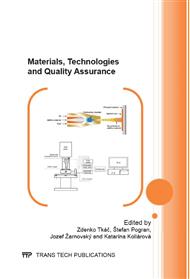[1]
Y. Fang, M. Zhan, Y. Wang, The status of recycling of waste rubber, Materials and Design. 22(2) (2000) 123-127.
Google Scholar
[2]
T. Duranik, J. Ružbarský, M. Stopper, Avoiding waste in manufacturing industries by using lean production methods, World Academy of Science, Engineering and Technology. 63 (2012) 342-345.
Google Scholar
[3]
V. Duchacek, Polymers: production, properties, processing, 2nd ed., VŠCHT, Prague, 2006.
Google Scholar
[4]
Shi Ai Xu, Gong Tao Wang, Yiu Wing Mai, Effect of hybridization of liquid rubber and nanosilica particles on the morphology, mechanical properties, and fracture toughness of epoxy composites, Material Science. 48 (2013) 3546-3556.
DOI: 10.1007/s10853-013-7149-4
Google Scholar
[5]
M.R. Dadfar, F. Ghadami, Effect of rubber modification on fracture toughness properties of glass reinforced hot cured epoxy, Materials and Design. 47 (2013) 16-20.
DOI: 10.1016/j.matdes.2012.12.035
Google Scholar
[6]
S.K. Subramaniyan, S. Mahzan, M.I. Ghazali, M.I. Ismon, A.M.A. Zaidi, Mechanical behavior of polyurethane composite foams from kenaf fiber and recycled tire rubber particles, Applied Mechanics and Materials, 3rd International Conference on Mechanical and Manufacturing Engineering, ICME 2012, November 2012, pp.861-866.
DOI: 10.4028/www.scientific.net/amm.315.861
Google Scholar
[7]
C. Cerbu, I. Curtu, Mechanical characterization of the glass fibres/rubber/resin composite material, Materiale Plastice. 48(1) (2011) 93-97.
Google Scholar
[8]
X. Lv, Y. Sun, Z. Jiang, Y. Zhang, M. Di, Mechanical property of nano-particles reinforced epoxy resin composite materials, Advanced Materials Research. 181-182 (2011) 99-102.
DOI: 10.4028/www.scientific.net/amr.181-182.99
Google Scholar
[9]
D. Garcia, J. Lopez, R. Balart, R.A. Ruseckaite, P.M. Stefani, Composites based on sintering rice husk–waste tire rubber mixtures, Materials and Design. 28 (2007) 2234-2238.
DOI: 10.1016/j.matdes.2006.06.001
Google Scholar
[10]
H. Ku, M. Trada, T. Cecil et al., Tensile tests of phenol formaldehyde glass-powder reinforced composites: Pilot study, Journal of Applied Polymer Science. 116 (2010) 10-17.
DOI: 10.1002/app.31424
Google Scholar
[11]
P. Valášek, M. Brožek, Two body abrasion of composites containing filler on the basis of hard cast iron deposits utilizable in agrocomplex, Agronomy Research. 11(1) (2013) 163-170.
Google Scholar
[12]
P. Valášek, M. Müller, A. Proshlyakov, Effect of sedimentation on the final hardness of polymeric particle composites, Research in Agricultural Engineering. 58 (2012) 92-98.
DOI: 10.17221/5/2011-rae
Google Scholar
[13]
M. Müller, P. Valášek, Abrasive wear effect on Polyethylene, Polyamide 6 and polymeric particle composites, Manufacturing Technology. 12 (2012) 55-59.
DOI: 10.21062/ujep/x.2012/a/1213-2489/mt/12/1/55
Google Scholar
[14]
T. Duranik, J. Ružbarský, F. Manlig, Proposal for possibilities of increasing production productivity of thermosets compression molding with using process simulation software, Applied Mechanics and Materials. 308 (2013) 191-194.
DOI: 10.4028/www.scientific.net/amm.308.191
Google Scholar
[15]
M. Müller, P. Hrabě, Overlay materials used for increasing lifetime of machine parts working under conditions of intensive abrasion, Research in Agricultural Engineering. 59(1) (2013) 16-22.
DOI: 10.17221/64/2011-rae
Google Scholar
[16]
M. Müller, P. Valášek, P. Novák, P. Hrabě, J. Paško, Overlays and composites application in technology of sugar beet cultivation and harvest, Listy cukrovarnické a řepařské. 127 (9) (2011) 304-307.
Google Scholar
[17]
I. Kováč, J. Žarnovký, R. Drlička, J. Ružbarský, An improvement of tribological properties of boron alloyed layers, Manufacturing Technology. 10 (2010) 78-80.
DOI: 10.21062/ujep/x.2010/a/1213-2489/mt/10/1/78
Google Scholar
[18]
J.M. Berthelot, Composite materials – mechanical behavior and structural analysis, Mechanical Engineering Series, Berlin, 1998.
Google Scholar


